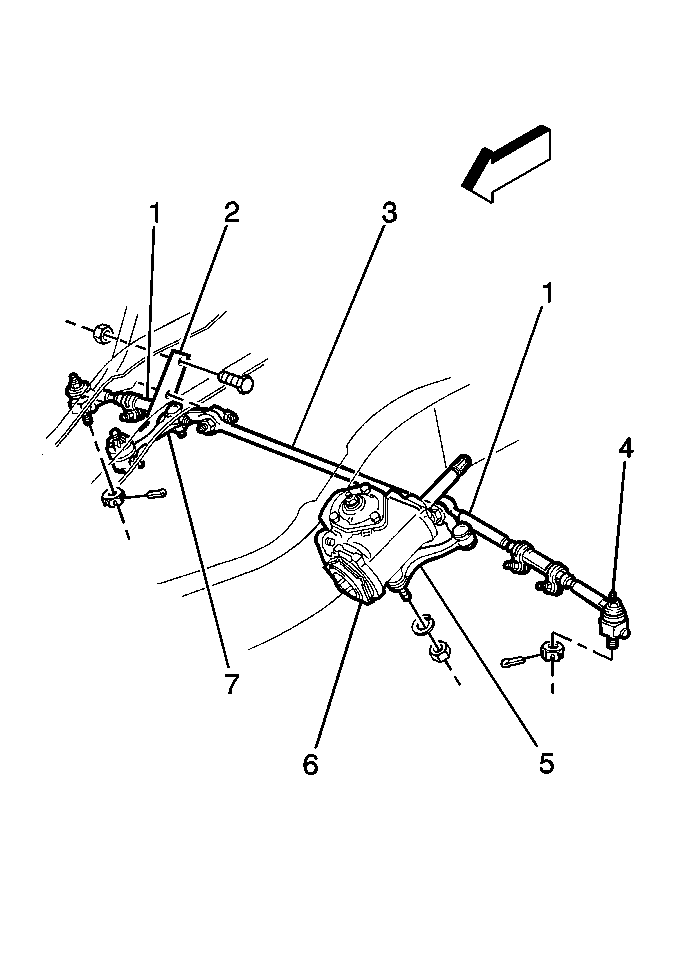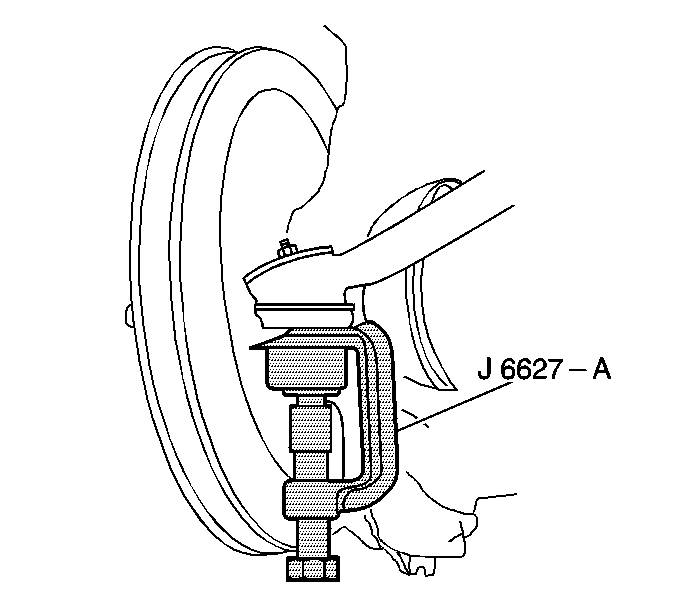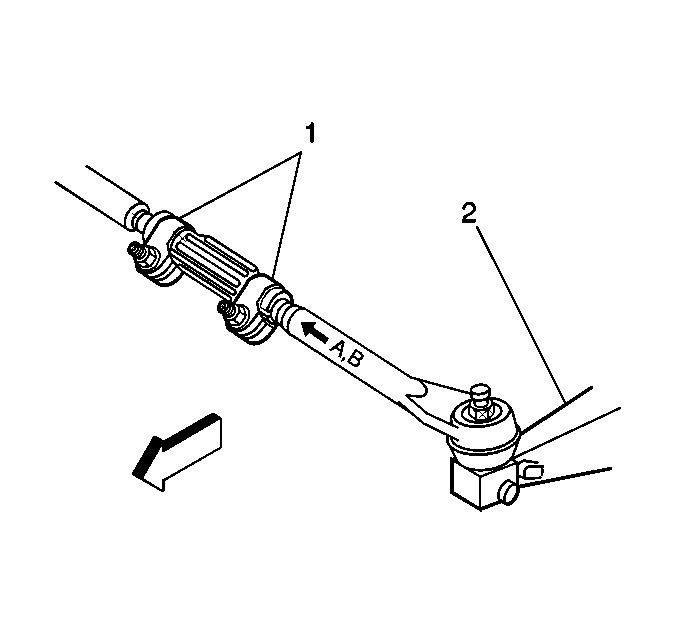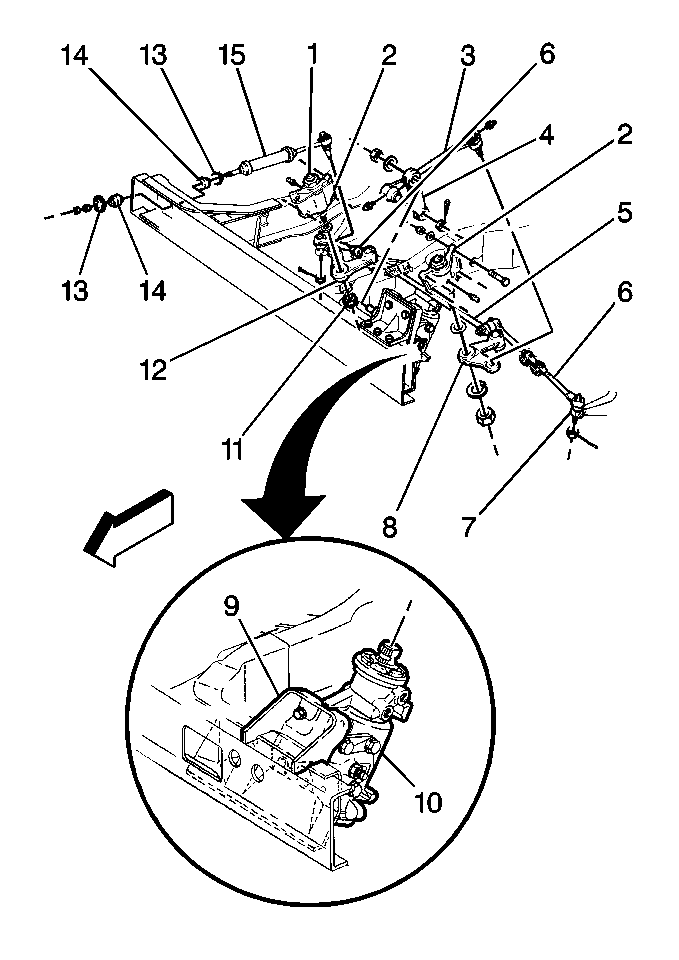Tie Rod Replacement Commercial
Removal Procedure
Tools Required
J 6627-A Tie Rod
Puller/Wheel Stud Remover

- Before undertaking any
service, note the following conditions:
| • | The position of the tie rod adjuster tube |
| • | The direction from which the bolts are installed |
| • | The tie rod adjuster tube components (1) may be rusted: |
| - | If the torque required in order to remove the nut from the bolt
exceeds 9 N·m (80 lb in), discard the nuts and
the bolts. |
| - | Apply penetrating oil between the clamp and the tube. |
| - | Rotate the clamps until they move freely. |
| - | Install all parts, with the correct part number, in the proper
position. |
- Raise and support the vehicle. Refer to
Lifting and Jacking the Vehicle
in General Information.
- Remove the cotter pins and the castellated nuts from the outer
tie rod ball studs.
Notice: Do not attempt to disconnect a steering linkage joint by driving a wedge
between the joint and the attached part. Seal damage may result which will
cause premature failure of the joint.

- Use the J 6627-A
in order to remove the outer tie rod
ball studs from the steering knuckle.
- Use the J 6627-A
in order to remove the inner tie rod ball studs from the relay rod.
- Loosen the clamp bolts from the tie rod end adjuster tubes.
- Remove the tie rod ends by unscrewing the tie rod ends from the
adjuster tubes.
- Clean the following components:
| • | The threads on the ball stud |
| • | The threads in the ball stud nut |
Installation Procedure
Tools Required
| • | J 29193 Steering
Linkage Installer (12 mm) |
| • | J 29194 Steering
Linkage Installer (14 mm) |

- If you removed the tie
rod ends, lubricate the tie rod threads with chassis lubricant. Refer to
Fluid and Lubricant Recommendations
in Maintenance and Lubrication.
- Install the tie rod ends to the adjuster tube.
The number of threads on both the inner and the outer rod ends must
be equal within 3 threads.
- Install the inner tie rod ball studs to the relay rod, tightening
the installer tool.
Ensure that the seal is on the stud.
Tighten
Tighten the J 29193
or the J 29194
to
54 N·m (40 lb ft) in order to seat the tapers.
- Remove the J 29193
or the J 29194
.

Notice: Use the correct fastener in the correct location. Replacement fasteners
must be the correct part number for that application. Fasteners requiring
replacement or fasteners requiring the use of thread locking compound or sealant
are identified in the service procedure. Do not use paints, lubricants, or
corrosion inhibitors on fasteners or fastener joint surfaces unless specified.
These coatings affect fastener torque and joint clamping force and may damage
the fastener. Use the correct tightening sequence and specifications when
installing fasteners in order to avoid damage to parts and systems.
- Install the prevailing
torque nut to the inner tie rod ball stud.
Tighten
Tighten the torque nut to 90 N·m (66 lb in).
Refer to
Fastener Tightening Specifications
.
- Install the outer tie rod ball studs to the steering knuckle (4).
- Install the castellated nuts and the cotter pins to the outer
tie rod ball studs. Advance each nut in order to align the nut slot with the
cotter pin hole. Do not back off the nut in order to align the cotter pin
hole. Insert a new cotter pin of the correct size.
Tighten
Tighten the castellated nuts to 62 N·m (46 lb ft).
Refer to
Fastener Tightening Specifications
.
- Adjust the toe-in. Refer to
Front Toe Adjustment
.

- Position the clamps on
the adjuster tubes between the locating dimples (1). Clear of the
dimples at either end of the adjuster tube before tightening the nuts.

- Position the clamps within
the angular travel as shown with the rearward rotation (2) of 45 degrees.
The slot (1) of the adjuster tube must not be within the area (3)
of the clamp jaws.
- Ensure that both of the outer tie rod ends rotate throughout the
full travel of the outer tie rod end.
- Maintain the position of each tie rod end while you tighten the
clamps in order to ensure free movement of each joint.

- Ensure that the gap next
to the adjuster tube (1) is NOT less than 0.127 mm (0.005 in).
- The clamp ends may touch when the nuts are tightened to specifications.
Tighten
Tighten the adjuster tube clamp bolts to 68 N·m (50 lb ft).
- Lower the vehicle.
Tie Rod Replacement Motorhome
Removal Procedure
Tools Required
J 6627-A Tie Rod
Puller/Wheel Stud Remover

- Before undertaking any
service, note the following conditions:
| • | The position of the tie rod adjuster tube |
| • | The direction from which the bolts are installed |
| • | The tie rod assembly (6) adjuster tube components may be rusted: |
| - | If the torque required in order to remove the nut from the bolt
exceeds 9 N·m (80 lb in), discard the nuts and
the bolts. |
| - | Apply penetrating oil between the clamp and the tube. |
| - | Rotate the clamps until they move freely. |
| - | Install all parts, with the correct part number, in the proper
position. |
- Raise and support the vehicle. Refer to
Lifting and Jacking the Vehicle
in General Information.
- Remove the cotter pins and the castellated nuts from the outer
tie rod ball studs.
Notice: Do not attempt to disconnect a steering linkage joint by driving a wedge
between the joint and the attached part. Seal damage may result which will
cause premature failure of the joint.

- Use the J 6627-A
in order to remove the outer tie rod
ball studs from the steering knuckle.
- Use the J 6627-A
in order to remove the inner tie rod ball studs from the relay rod.
- Loosen the clamp bolts from the tie rod end adjuster tubes.
- Remove the tie rod ends by unscrewing the tie rod ends from the
adjuster tubes.
- Clean the following components:
| • | The threads on the ball stud |
| • | The threads in the ball stud nut |
Installation Procedure
Tools Required
| • | J 29193 Steering
Linkage Installer (12 mm) |
| • | J 29194 Steering
Linkage Installer (14 mm) |

- If you removed the tie
rod ends, lubricate the tie rod threads with chassis lubricant. Refer to
Fluid and Lubricant Recommendations
Maintenance and Lubrication.
- Install the tie rod ends to the adjuster tube.
The number of threads on both the inner and the outer rod ends must
be equal within 3 threads.
- Install the inner tie rod ball studs to the relay rod.
Ensure that the seal is on the stud.
- Tighten the J 29193
or the J 29194
to 54 N·m (40 lb ft) in order to seat the tapers.
- Remove the J 29193
or the J 29194
.

Notice: Use the correct fastener in the correct location. Replacement fasteners
must be the correct part number for that application. Fasteners requiring
replacement or fasteners requiring the use of thread locking compound or sealant
are identified in the service procedure. Do not use paints, lubricants, or
corrosion inhibitors on fasteners or fastener joint surfaces unless specified.
These coatings affect fastener torque and joint clamping force and may damage
the fastener. Use the correct tightening sequence and specifications when
installing fasteners in order to avoid damage to parts and systems.
- Install the prevailing
torque nut to the inner tie rod ball stud.
Tighten
Tighten the nut to 90 N·m (66 lb in). Refer
to
Fastener Tightening Specifications
.
- Install the outer tie rod ball studs to the steering knuckle (7).
- Install the castellated nuts and the cotter pins to the outer
tie rod ball studs. Advance each nut in order to aligh the nut slot with the
cotter pin hole. Insert a new cotter pin of the correct size.
Tighten
Tighten the nuts to 62 N·m (46 lb ft). Refer
to
Fastener Tightening Specifications
.
- Adjust the toe-in. Refer to
Front Toe Adjustment
in Wheel Alignment.

- Position the clamps on
the adjuster tubes between the locating dimples (1). Clear of the
dimples at either end of the adjuster tube before tightening the nuts.

- Position the clamps within
the angular travel as shown with rearward rotation (2) of 45 degrees.
The slot (1) of the adjuster tube must not be within the area (3)
of the clamp jaws.
- Ensure that both of the outer tie rod ends rotate throughout the
full travel of the outer tie rod end.
- Maintain the position of each tie rod end while you tighten the
clamps in order to ensure free movement of each joint.

- Ensure that the gap next
to the adjuster tube (1) is NOT less than 0.127 mm (0.005 in).
- The clamps ends may touch when the nuts are tightened to specifications.
Tighten
Tighten the adjuster tube clamp bolts to 68 N·m (50 lb ft).
- Lower the vehicle.
Tie Rod Replacement I-Beam Front Axle
Removal Procedure
Tools Required
J 6627-A Tie Rod
Puller/Wheel Stud Remover
Notice: Do not attempt to disconnect a steering linkage joint by driving a wedge
between the joint and the attached part. Seal damage may result which will
cause premature failure of the joint.

- Raise and support the
vehicle. Refer to
Lifting and Jacking the Vehicle
in General Information.
- Remove the cotter pins and the castellated nuts from the outer
tie rod ball studs.
- Remove the shock absorber (4) from the tie rod assembly (6)
and from the frame.

- Use the J 6627-A
in order to remove the tie rod ball
studs from the steering knuckles.
- Clean the following components:
| • | The threads on the ball stud |
| • | The threads in the ball stud nut |
- Inspect the tie rod assembly components. Refer to
Tie Rod End Inspection
.
Installation Procedure
Tools Required
| • | J 29193 Steering
Linkage Installer (12 mm) |
| • | J 29194 Steering
Linkage Installer (14 mm) |

- Lubricate the tie rod
threads with chassis lubricant. Refer to
Fluid and Lubricant Recommendations
.
- Tighten the J 29193
or the J 29194
to 54 N·m (40 lb ft) in order to seat the tapers.
- Remove the J 29193
or the J 29194
.

- Install the tie rod assembly (6)
to the steering knuckles.
Notice: Use the correct fastener in the correct location. Replacement fasteners
must be the correct part number for that application. Fasteners requiring
replacement or fasteners requiring the use of thread locking compound or sealant
are identified in the service procedure. Do not use paints, lubricants, or
corrosion inhibitors on fasteners or fastener joint surfaces unless specified.
These coatings affect fastener torque and joint clamping force and may damage
the fastener. Use the correct tightening sequence and specifications when
installing fasteners in order to avoid damage to parts and systems.
- Install the castellated
nuts and the cotter pins to the tie rod ball studs. Advance each nut in order
to align the nut slot with the cotter pin hole. Do not back off the nut in
order to align the cotter pin. Insert a new cotter pin of the correct size.
Tighten
Tighten the nut to 220 N·m (162 lb in). Refer
to
Fastener Tightening Specifications
.
- Install the shock absorber (4) to the tie rod assembly (6).
Tighten
Tighten the nuts to 62 N·m (46 lb ft). Refer
to
Fastener Tightening Specifications
.
Important: The wheel toe-in adjustment nuts of a new tie rod assembly are hand
tightened. When replacing a tie rod assembly, the wheel toe-in adjustment
nuts must be tightened to the proper torque upon installation. The wheel
toe-in reading must correspond to the recommended wheel toe-in specification.
- Adjust the toe-in. Refer to
Wheel Alignment Specifications
. When the wheel toe-in reading corresponds
to the recommended wheel toe-in figure, tighten the 2 adjustment
nuts (2) on the tie rod.
Tighten
Tighten the first nut and the jam nut (closest to shock absorber connection)
to 375 N·m (277 lb ft).
- Lower the vehicle.


















